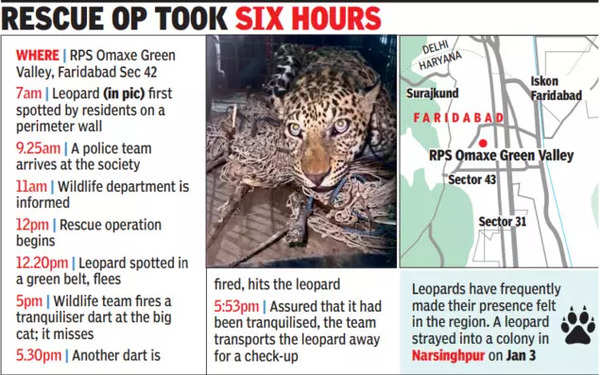
A resident of RPS Omaxe Green Valley in Sector 42 first saw the leopard from his flat’s window “napping” on the perimeter wall of the apartment complex at 7am.
“An advisory was issued for residents immediately, and local police and the wildlife department were informed,” said Manish Kumar, who saw the big cat.
A search was initiated as cops reached the society, but the leopard had moved by then. It took four hours to spot the leopard in the complex, and another six to seven hours to tranquilise the animal.
Around noon, the wildlife team went to the roof of a house and fired multiple tranquiliser shots, officials said. They missed the first few shots but one of them got the big cat who was unconscious by 5.30pm.
The residents gathered on their balconies, capturing photos and videos of the animal.
“It took around six hours to tranquilise the male leopard. The leopard was safely and swiftly rescued without any injury to residents or to the animal. We will conduct a health check-up of the big cat at the Sona wildlife rescue centre,” said MS Mallik, additional principal chief conservator of forests and wildlife (south Haryana).
The leopard, believed to be three and a half years old, will be released back into the Aravalis once the veterinary department gives an all-clear.
Wednesday’s incident was the second such sighting of a leopard in south Haryana in less than two months. On January 3, a leopard strayed into a colony in Narsinghpur, Gurgaon. Trying to escape the village, the leopard lunged at a 13-year-old who sustained minor injuries. The big cat was caught after being confined and locked in a room at a resident’s house.
Both Faridabad and Gurgaon are developed around the Aravali hills that are home to leopards. A Wildlife Institute of India (WII) report in 2017 had pointed out that the belt is a rich leopard habitat along with an abundance of wildlife thriving in this part of the Aravalis.
Chetan Agarwal, a forest analyst, said on Wednesday that rapid urbanisation is eating into the region’s forest cover, forcing wild animals to stray into residential colonies.
“Incidents of leopards straying into these areas are increasingly becoming common. The Green Valley society is flanked by the Aravalis on its west, which is connected to the Asola wildlife sanctuary. This adjacent Aravali area is part of natural conservation zones that are ecologically sensitive areas where construction is restricted to only 0.5% of the total area. However, the new draft of NCR Planning Board’s regional plan does away with this 0.5% restriction, and the 2023 amendment in the Forest (Conservation) Act threatens one-thirds of the Aravalis in Faridabad by making it a non-forest zone. In such a situation, what can a leopard do except enter concrete ‘Green Valley’,” he said.